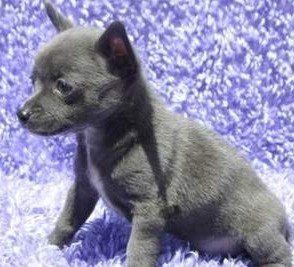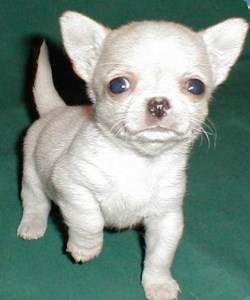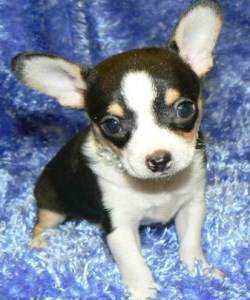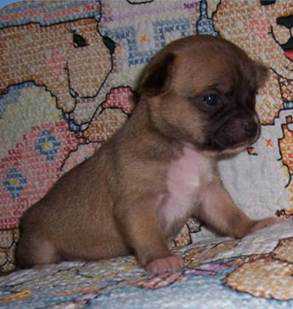Chihuahua Colors
It's a rare and beautiful coloring to see a Chihuahua that reminds you of a Dalmatian! This white with black spots is technically called 'Spotted on White' and is AKC color code S 0171 (standard markings).
Photo of Roxy and Gracie courtesy of Lynne Sheldon
Lake Bluff, Illinois
Overview
You may wonder what color your Chihuahua is. Dogs come in such a wide range, it is sometimes confusing to know the official one. Beyond wanting to know for self satisfaction and to be able to tell others, you need to give a color when registering your Chihuahua.
The names may be a bit misleading, such as a blue Chihuahua which certainly is not actually the color blue. Can you imagine?
Does Color Really Matter?
Understanding color information is important in regard to registering your dog. In dog shows, all different Chihuahuas are allowed to enter and one is not judged to be a better color than another one.
For example, a black Chihuahua is not considered more valuable than a parti-color dog. You may, of course, have a preference for a certain color.
If you are buying a Chihuahua dog and want a particular color, it is recommended to find a good breeder ahead of time. You can ask that breeder if he or she has plans to breed a certain color.
Experienced breeders carefully pair dogs together to produce litters in the color that they are striving for...but remember that Mother Nature has the last say.
List of Chihuahua Colors
One of the wonderful elements about the Chihuahua, is that this dog breed has a large variety of colors.
With so many colors and so many markings, this makes each Chihuahua very unique. There are 30 AKC recognized colors (some are combinations). There are also 11 recognized markings that a Chihuahua may have.
Let's first look at the list of colors:
Note that with color codes, 'S' denotes a standard color and 'A' denotes an alternate color (still accepted).
* Black (S 007)
* Black & Tan (S 018)
* Blue & Tan (S 044)
* Chocolate (S 071)
* Chocolate & Tan (S 072)
* Cream (S 076)
* Fawn (S 082)
* Fawn & White (S 086)
* Red (S 140)
* Black & Red (A 014)
* Black & Silver (A 016)
* Black & White (A 019)
* Black Sabled Fawn (A 354)
* Black Sabled Silver (A 353)
* Blue (A 037)
* Blue & White (A 045)
* Blue Brindled Fawn (A 356)
* Blue Fawn (A 036)
* Chocolate & White (A 271)
* Chocolate Blue (A 359)
* Chocolate Brindled Fawn (A 355)
* Chocolate Sabled Fawn (A 358)
* Cream & White (A 077)
* Fawn Brindled Black (A 357)
* Gold (A 091)
* Gold & White (A 092)
* Red & White (A 146)
* Silver (A 176)
* Silver & White (A 182)
* White (A 199)
Aside from the base color of the coat, there are 11 official markings that a Chihuahua may have:
* Black Brindling (S 073)
* Black Mask (S 004)
* Black Sabling (S 072)
* Merle Markings (S 035)
* Spotted On White (S 071)
* White Markings (S 014)
* Black Mask, White Markings (A 005)
* Blue Mask (A 006)
* Cream Markings (A 044)
* Fawn Markings (A 008)
* Red Markings (A 023)
Descriptions
Since there are so many colors of the Chihuahua dogs and a lot of owners wondering about all of these... let's try to sort out exactly what some of the colors actually mean:
Black Sable Fawn:
This Chi will be fawn with black sabling. Sable refers to black tipped hairs. Therefore, the base color will be fawn (light tan) and the tipping of the hairs will be black. This creates a textured appearance that is quite beautiful.
Black:
A full, solid black is very rare. Many black Chihuahua dogs will have some type of marking on the body.
Red:
This can range from a dark orange or a brown/orange and is often referred to as mahogany.
Brindle:
This is actually a pattern. It is a particular striping. Most brindle Chihuahuas are black over fawn; this will look similar to 'tiger stripes' which can be thin or thick.
Chocolate:
Chocolates have brown fur; however, there is more to it than this. A true chocolate colored Chihuahua will be so based on skin color. Instead of black eye rims, nose, lips, and paw pads, these areas of skin pigmentation will be brown.
Merle:
This is a splashed pattern, usually with blue or black splashes. This color may carry through to the eyes as well. The gene that creates this produces random dilutions to the coat of the Chihuahua. It is important to never breed two Merles together as it can produce puppies that have issues with sight and/or hearing and other
health problems.
Fawn:
This is a light tan that may have an undertone of red.
Gold:
Shinier than fawn, especially noticeable when the Chi is outside.
Blue:
Blue is determined by skin color. The coat may appear to be any shade or variance of black. It is the skin pigmentation that classifies a Chihuahuas as blue; the paw pads, lips, eye rims and nose will be blue. For many Chihuahuas, these areas may appear black, however under bright light (outdoor sunlight works well), there will be a noticeable bluish tint.
Blue & Tan:
Blue, as described above, with tan points, usually with tan tips on the paws. Some have tan around the ears and/or above the eyes.
Gray & Silver:
Many ask what the difference is between gray and silver on a dog. The element that makes silver, is that white slivers will slice through the gray coat, producing a color that is shinier than an otherwise standard gray.
Examples of Colors
Let's take a look at some of the more interesting Chihuahua colors:

Photo courtesy of Candy O’Farm Chihuahuas
Blue
- A lot of people are curious about the blue Chihuahua. And it is truly a rare, unique coat coloring. Blue coats appear when there is a diluted black gene. While some will indeed show a blue tint on the coat, with many you will need to look to the skin points to differentiate blue from black.
With most blue Chihuahuas
the fur will be black, (either dull, muted or shiny) but the nose will have a blue tint to it that is most noticeable in the direct sunlight. Other skin points that will show blue are the lips, eye rims, and paw pads. In some cases, the dog's eyes may also be blue.

Red Fawn Sable -
This is sabling, which are black tipped hairs, on a base of red fawn. This Chihuahua would be listed as a red with sable markings.
Photo courtesy of Highland Hills Chihuahuas

White -
This little guy is a perfect, solid white
Chihuahua. As you can imagine, with all of the possible colors that exist in the bloodlines, a solid Chihuahua is rare and a solid white such as this one is exceedingly rare.
Photo courtesy of A-Mayer’s Tinys

Blue Fawn -
A very light, pale color combination, as you can see. The blue fawn will be a diluted black which creates blue, and fawn (which is a very light tan).
Photo courtesy of Sheppard’s Chihuahua Ranch

Brindle -
Brindle itself is not a color per se, it describes a pattern of coloring. It refers to dark stripes on a lighter background. This little sleeping beauty has a beautiful brindle coat.
Yodi, photo courtesy of Olivia And Jonathan

Black & Tan
Even if there is a third color (tri color), a Chihuahua will be a two-color combo, and the third color (often the one that appears least) will be a marking. This is a black and tan Chihuahua with white markings.
Cid, photo courtesy of Maria Ortiz

Chocolate - This Chihuahua has a brown nose and a brown coat (with white), making him a chocolate with white markings.
Peanutbutter, photo courtesy of Lisa Byrd
Examples of Markings
There are many types of gorgeous color markings that can appear on a Chihuahua:

Tan markings
do not necessarily need to fall on a solid colored coat. This is a black & white Chihuahua with tan markings. Note that this pup could also be classified as a black & tan with white markings.
Photo courtesy of Little Blue’s Smok’in Chili Pepper’s Chihuahuas

Black Mask, White Markings
- This is a very rare marking. This puppy has the black coloring around the eyes and muzzle (mask) and then white markings on the chest. The base coat of the Chi may be any color and this pup has a base of fawn.
Photo courtesy of Cathy’s Charming Chihuahuas

Kiss marks
– Kiss marks on a dog are not considered to be an official marking; however they are quite stunning.
This refers to a patch of color on the dog's eyebrow area; which accentuates the face very nicely.
Photo courtesy of Candy O’Farm Chihuahuas
Eye Color
Chihuahuas, per AKC standard, are to have luminous (shiny) dark or ruby eyes. White or light tan dogs may have light eyes (hazel). Dark refers to brown or black.
What do ruby eyes on a Chihuahua mean? Ruby means that dark eyes, under certain lighting conditions, appear to be red. In general, only white or light colored Chi have ruby eyes and they will appear to be a dark red at night or if the light hits them just right.
Blue eyes can be found with this breed, however are considered to be a fault.
Coat Color Changes
It is not uncommon for the coat color of a Chihuahua to change. This often happens during the first years as puppy fur lets loose for the adult coat. Sabling can lighten or darken, brindling can lessen or deepen and a color such as tan can lighten to a beige or brighten to a gold. By the time a Chi is 1 year old, the coat color will generally stay the same.
For some senior Chihuahuas, there can be a slight greying to the fur, this is never a dramatic change, but more of graying usually involving the facial hairs and scattered throughout the coat, sometimes only noticeable in bright sunlight.



